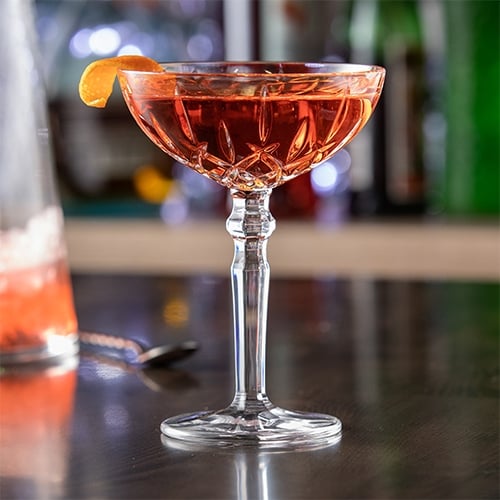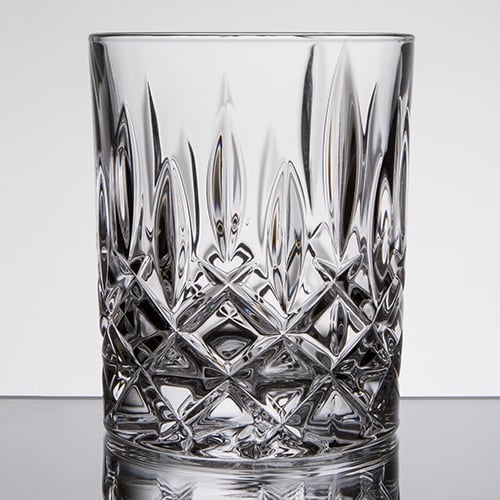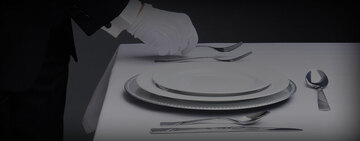Fine dining restaurants are known for delivering the highest level of customer service. Guests expect elegant ambiance, upscale table settings, and a menu with higher price points. They also expect servers to uphold fine dining etiquette. We’ve made a guide of fine dining etiquette tips to help new servers provide their guests with the most professional service possible.
Click any of the server etiquette tips below to learn more about fine dining rules:
Preparing for Service
Formal Table Settings
Service Etiquette
Cutlery Etiquette
How to Serve Wine
Clearing the Table
Grooming and Behavior
Tableside Service
Etiquette FAQs
Server Etiquette Tips
Fine dining can be intimidating and mysterious to the uninitiated. Other styles of serving customers are usually picked up intuitively, but many aspects of fine dining are dictated by rules and traditions that must be learned. Whether you're new to the restaurant industry or you've been serving for many years, our list of fine dining server tips is an excellent introduction to the world of fine dining service and etiquette.
1. Preparing for Service
Before dinner service begins, the dining room must be put in order. Mise en place is a kitchen term that translates to "put into place", but it's also used in fine dining to describe the act of preparing dining tables, flatware, and tableware for service. With every detail accounted for, dinner service can be performed smoothly and without interruption. Fine dining servers should begin their shift by attending to the following tasks:
Tableware - Each piece of tableware used for service should be inspected for chips, irregularities, and cleanliness. Flatware, glassware, and any silver pieces should be polished to remove water spots. While polishing, cotton gloves can be worn to eliminate fingerprints.
Mise en Place Stations - A mise en place station is a server station set up with all items needed for service. Additional flatware, drinkware, or servingware needed for meal courses is stored at the station where it can be quickly retrieved. It's the server's responsibility to prepare the mise en place station before guests arrive.
Dining Tables - Dining tables should be wiped down, inspected for wobbly legs, and arranged according to guest reservations. A special cloth called a molleton cloth is placed on the table prior to laying the tablecloth to muffle the sound of dishes and glassware being placed on the table.
Lighting - Light all candles and mood lighting before dinner service begins.
2. Formal Table Settings
The type of table setting you use helps set the tone for service. As soon as guests are seated, they know the service will be excellent if they see an impeccable table setting. As a fine dining server, you should be very familiar with formal table settings so you can set the table yourself or add finishing touches before your guests arrive.
Number of Pieces - Only set the table with the dinnerware pieces and utensils that will be used during the dinner. This may be up to twenty pieces for a full course meal.
Linens - All linens should be freshly laundered and wrinkle free. Place a cloth napkin to the left of the salad fork or directly on the dinner plate. Drape the tablecloth over the table so the overhang length is equal on all sides.
Flatware - Forks always go to the left, while knives and spoons are on the right. Follow this simple rule to place the cutlery in the correct order: the utensils are always placed in order of use, beginning from the outside in. Place the dessert spoon and dessert knife above the dinner plate.
Glassware - Glasses are placed to the upper right of the dinner plate. The water glass is first, followed by a white wine glass, a red wine glass, champagne flute, and sherry glass. If tea or coffee is being served, place a teacup and saucer to the right of the spoons and knives.
Use Symmetry - Use symmetry to make sure the table setting is balanced. If needed, a ruler comes in handy to measure distances between the pieces so that every setting at the table is identical.
Avoid Fingerprints - Hold glassware and flatware by the stem to minimize the appearance of fingerprints. Better yet, wear white server gloves when handling all dinnerware.
3. Proper Etiquette for Service
The style of serving used in formal dining represents the highest level of hospitality. It elevates the guest experience and makes fine dining a memorable event. A great fine dining server will be detail-oriented, observant, and intuitive. Anticipating the needs of guests while remaining unobtrusive is the key to providing the best service possible.
Present the Menu and Drink List - As the guests are seated, present each diner with the menu and wine list. Do not hand off the menus in a rush. Match the pace of the table and present the menus after each individual is comfortably seated.
Describe the Evening's Specials - Observe the table and wait for the right moment to describe the evening's specials. Speak clearly and describe each dish in detail, pausing to answer any specific questions. This is also a good time to inquire about possible dietary restrictions.
Additional Tableware - After the guests have ordered, you may need to prepare additional items for each course. For example, orders of fish will require a fish knife and fork. An order of freshly shucked oysters will require an oyster fork. Deliver any required cutlery, tableware, or condiments to the table shortly before the course is served.
Open Hand Service - Many formal restaurants practice the open hand service method, which requires that a server's arms are never to be crossed in front of a guest. If serving from the right side of a guest, use the right arm. Use the left arm when serving from the left. This prevents the active arm from reaching across a guest. Each fine dining establishment has a preferred side for serving, so make sure to follow the specific guidelines of your manager.
Control the Pace - As a fine dining server, you must be able to read the table and match the pace of your guests. Every guest prefers a different pace, and it's your job to determine their needs through verbal clues and body language. For example, if all the guests are seated with napkins on their laps and they looking expectantly around, they are most likely ready to hear the specials. If everyone at the table is enjoying their coffee and the guests are deep in conversation, they are probably not ready for the check.
4. Cutlery Etiquette
Resting cutlery etiquette is a method of non-verbal communication used in formal dining service. The guest places their flatware on the dinner plate in a certain position to signal their needs to the server. The benefit of understanding cutlery etiquette is the server can meet the guest's needs without interrupting the table's conversation.
Ready for the Next Dish - To signal that the guest is finished with their plate and ready for the next dish, the knife and fork are placed in the shape of a cross on the plate. It's customary to wait until all guests are finished with their dish before clearing the plates.
Pause - If a guest needs to get up from the table but doesn't want their plate removed, they can use their flatware to indicate they are taking a pause. In this case, the knife and fork are placed on top of the plate in the shape of an inverted V.
Food Was Excellent - If a guest wants to show their appreciation for the dish, they will place their knife and fork on top of the plate in a horizontal position with the blade and tines facing to the right.
Finished with Meal - To indicate that the meal is over, the guest will place the knife and fork side by side in a vertical position on top of their plate. When all guests are finished, it's a good time to present the dessert list and take a coffee order.
Unhappy with Dish - If the guests is unhappy with their dish, they will place the knife and fork in the shape of an inverted V with the knife inside the tines of the fork. No server wants to see this, but if it does happen, address the situation immediately.
5. How to Serve Wine
Proper wine service is essential to the art of fine dining. Instead of relying on a bartender to supply the wine, fine dining servers perform the wine service at the table, following the appropriate steps in the correct order. Impress any wine enthusiast with your meticulous service by following these guidelines:
Know How to Use a Wine Key - Using a wine key, or corkscrew, is not that difficult, but you should be able to swiftly open a bottle in the air with no hiccups. Practice using the corkscrew wine opener at home so that you can open bottles with confidence.
Bring All Items at Once - Bring everything you need for the service in one trip. You’ll need the wine bottle, a wine glass for every guest, a wine bucket with ice for chilled wines, and your corkscrew.
Present the Wine - Standard wine service requires that you present the wine bottle to confirm the selection is correct. Hold the wine bottle towards the guest who ordered it and state the name of the wine. Once the guest approves, you can begin the service.
Sampling - After uncorking the bottle, place the cork in front of the guest who ordered it, wet side up. Pour a small sample for the guest and wait patiently as they nose it, swirl it, and sip it. Once approved, you can begin pouring for the table.
Pouring - Pouring should be performed clockwise around the table, beginning with all ladies first, and ending with the guest who ordered the bottle.
Hands Off - Once the service has started, you should never touch the wine glasses on the table as you pour. If a guest signals that they do not wish to have wine, discreetly remove the glass at the end of the wine service.
6. Clearing the Table
The method for clearing away dishes from the table is just as important as serving. A table that’s cluttered with dishes and cutlery is distracting to the guests and takes away from the experience. For impeccable fine dining service, follow our guidelines for clearing the table:
Wait for All Guests to Finish - Traditionally, you should wait for all guests to finish the course before clearing. Flatware placed in a cross position or straight up and down on the plate is a signal that the guest is finished. The guest may also place their napkin on the table to indicate they are finished.
Remove Used Flatware - When clearing the plates, also remove any used flatware. The server mise en place station should be set up with the additional flatware you’ll need for the next courses.
Remove Condiments - Clear away any condiments that will not be used during the next course.
Clear From the Right - Always clear from the guest’s right side and follow a clockwise order around the table.
Don’t Stack Dishes - Stacking dishes while clearing may seem like an innocent time-saver, but it’s a no-no in fine dining. Instead, remove each plate from the table individually and stack it on a tray out of direct sight.
Crumb the Table - De-crumbing the table is a sign of superior hospitality. Use a hand-held tool, called a table crumber, to swipe table crumbs onto a small plate. This can be performed between courses as needed. The key to crumbing is to make your presence known without interfering with guests’ movements or conversation.
7. Grooming and Etiquette
Server grooming and behavior must be flawless in a fine dining setting. Whenever in view of guests, servers should carry themselves with professionalism and poise.
Uniforms - Server uniforms should be spotless and neatly pressed. If servers supply their own white shirts, they should meet the restaurant standard for color and style. A shirt that is slightly off-white might appear yellow or dingy compared to the rest of the staff.
Grooming - Hair should be neatly styled and pulled back from the face. Hands should be well-groomed with nails trimmed short. Avoid wearing cologne or perfume that may be distracting to guests. Jewelry should also be removed during service.
Posture - Always exhibit proper posture. Do not slouch, cross your arms, or put your hands in your pockets.
No Informal Conversation - Do not engage in informal conversations with guests or within the earshot of guests.
No Touching - Never touch a guest. The open hand method of serving makes it easier to serve guests without accidentally touching them with your arm. Refrain from touching your own uniform, face, or hair. If you have to make adjustments to your apron, do it out of sight.
No Pointing - Never point or gesture towards a guest. If a guest asks for the location of the restroom, do not point. Instead, gesture with an open hand to guide them in the right direction.
No Eating and Drinking - Never eat, drink, or chew gum in front of guests. Do not keep employee drinks at the server station. Follow your manager’s specific protocols for staff meal or meal allowances.
8. Types of Table Service
There are several types of table service in fine dining. Each type of service has rules and traditions that make it unique.
French Service - French service is considered one of the most lavish forms of service in fine dining. The two styles of French service are cart French service and banquet French service. Using the cart method, servers prepare dishes tableside for guests on a cart called a gueridon. Each guest is served from the right. With banquet service, the food is prepared in the kitchen and served from a platter onto each guest’s plate from the left.
Russian Service - Just like French cart service, dishes are prepared by servers at the tableside in Russian service. Dishes are arranged on attractive silver platters and delivered to the table from the guest’s left side. Guests pass the platters and serve themselves.
American Style Service - American style fine dining service is a common form of dining in which dishes are cooked and plated in the kitchen before being served to the guest’s right. There are some American style restaurants that follow the “serve from the left, clear from the right” method, so make sure to follow your manager's specific guidelines for service.
Butler Service - During butler service, the server presents a tray of menu items and guests are invited to serve themselves from the tray. This is the type of service often used at catered events to pass hors d’ oeuvres.
English - Commonly found in private dining rooms, English style service features a server individually serving each guest from a large platter, starting with the host. This style stems from English manor houses where the head of the house would do the carving, and then servants would distribute the portions.
Fine Dining Service FAQs
Fine dining service rules are based on longstanding traditions, but each restaurant may have their own interpretation for service. Below are some common topics of confusion related to fine dining:
Which Side Do You Serve From?
In most American service, pre-plated courses are served from the right and cleared from the right. Beverages are poured to the right, because glasses are located to the right of the guest. Other types of service, like Russian service, dictate that the guest is served to the left. Each fine dining restaurant has its own protocols for serving, whether it's to the right or left. The most important fine dining rule is to use open hand service and never cross your arm in front of a guest.
What Is Open Hand Service?
Open hand service is a method of placing items on a dining table without ever reaching across a guest. To perform this type of serving, always use the right arm to serve at the guest's right side, and the left arm to serve at the guest's left side. If you were to use the opposite arm, the awkward motion would result in your elbow pointing towards the guest.
Should You Serve Ladies First?
Traditionally, ladies are served first during every step of fine dining service, but there is a new school of thought that considers this an outdated practice. The best course of action is to follow the guidelines set by your front-of-house manager. If serving ladies first, it's common to begin with the oldest lady present and move clockwise around the table. Then another lap is required to serve the gentlemen. If this isn't your restaurant's protocol, a good practice is to use seat numbers as your guide.
Should Servers Be Clean Shaven?
Many fine dining establishments will require servers to be clean shaven. However, a number of the older traditions and rules of service have loosened over time. Facial hair may be acceptable to some fine dining restaurants, as long as it is neatly trimmed and groomed.
Fine dining servers carry a lot of responsibility, but the rewards for providing superior service are many. Higher price points and wine service produce a larger tab, which results in a larger gratuity for the server. Employees who pride themselves in their ability to provide outstanding hospitality can find job satisfaction in a fine dining role. Use our tips as a starting point to begin your journey in fine dining service.







